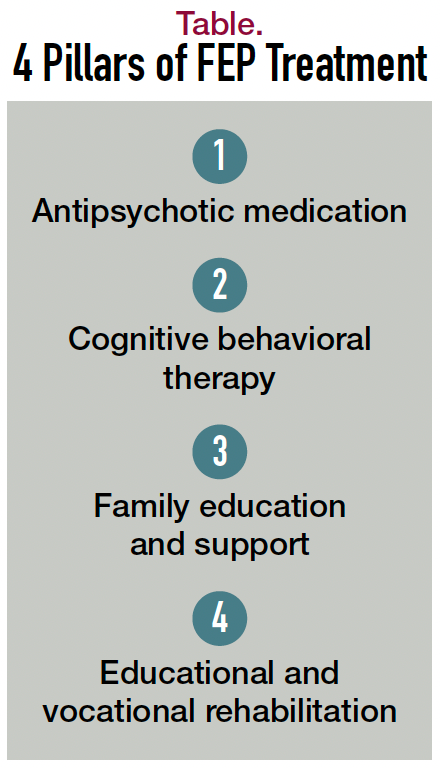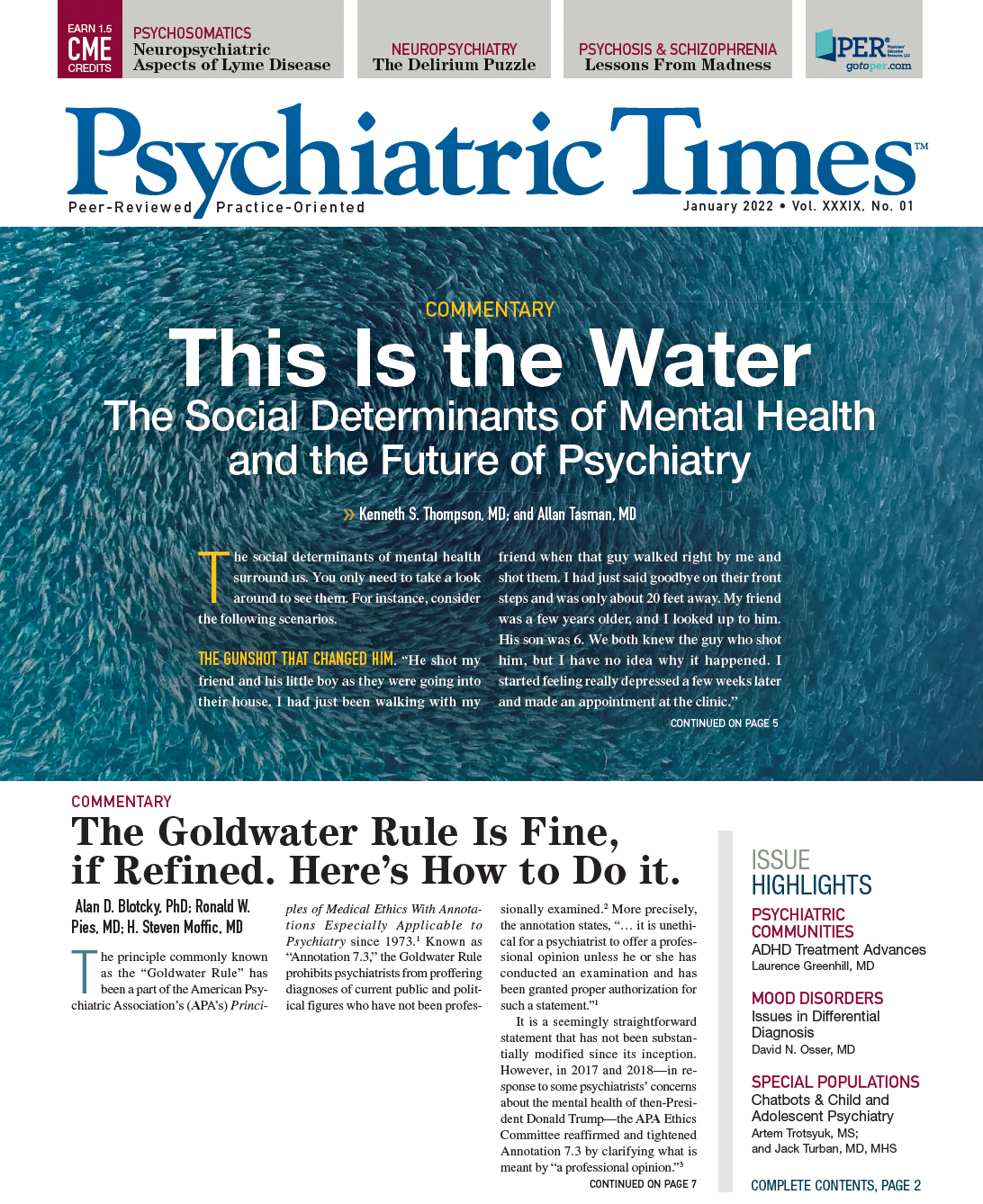Publication
Article
Psychiatric Times
Hope for the New Year
Author(s):
The glass is half full: reflections on where we are and hope for where we are heading in psychiatry.
chones/Adobe Stock

FROM THE EDITOR
Our tradition of making New Year’s resolutions is a good one, as we start the new year with hopefulness for improvements and growth for ourselves, humanity, and our planet. Unfortunately, all too often, by spring the resolutions are forgotten, as we fall into our usual routines and well-established habits. In psychiatry, our hope is often for a new treatment and ideally a cure for one of the many chronic and disabling conditions that are at the very center of our profession.
This past year, I read several articles as well as a book declaring that progress in psychiatric research is stagnant. These “glass half empty” opinions went so far as to claim that we have made no significant progress since the 1950s, when chlorpromazine and imipramine transformed psychopharmacology and were paradigm changes for our treatments for disorders such as schizophrenia and major depression. These writings went on to opine that all the research and drug development of the past 50 years have contributed very little to improved outcomes for our patients, and that all subsequent pharmacological agents developed are simply “me too” additions.
Working at a community mental health center, we serve a population that often has chronic symptoms, many of whom continue to decline in function over years and decades. Despite this, I hope to convince you that the glass is actually half full.
Psychiatry shares the challenges of all the other medical professions: many of the disease states that we treat have complex and multifactorial etiologies. These range from genetic vulnerabilities to intrauterine events to perinatal complications to environmental insults to results of suboptimal lifestyle behaviors to random accidents. Additionally, there is the simple fact that the great majority of us will die prior to the age of 100.
Yet it is quite remarkable that the average life expectancy in the United States was 48 years in 1900 and had increased to 79 years by 2020.1 Many factors have contributed to this striking increase in longevity, including a dramatic decrease in infant and child mortality rates, vaccinations, antibiotics, improved health care on many fronts, access to good nutrition for many, and the numerous advances in science and technology. And, although the life expectancy statistics look promising, they do not factor in the many possible acute and chronic diseases that can affect quality of life and virtually every organ system, including the brain.
Medicine continues to make great strides in technology, drugs, and treatments to minimize the impact of these diseases on quality of life and, in some cases, to cure them. However, virtually every medical specialty has disease states that persevere and, rather than being cured, are managed. Additionally, multiple factors—some modifiable and others unchangeable—will converge to accelerate or delay disease progression. Although the completion of the sequencing of all 3 billion base pairs in the human genome in 2003 was predicted to result in significant advances in diagnosing and treating all diseases, for the most part those advances did not happen.
According to the Centers for Disease Control and Prevention, the most common cause of death in the United States in 2019 continued to be heart disease.2 Despite the heart being a very straightforward and extensively studied organ—basically a pump—diseases of the heart continue to result in significant morbidity and functional impairment for many individuals. Does this mean that cardiology has failed as a specialty and no progress has been made? Of course not.
The human brain, the most complex organ known in the universe as of today, has many secrets awaiting our discovery. Over the past 100 years, we have merely begun our journey toward understanding the brain, and I posit that we have made great strides in treating psychiatric disorders, despite the likelihood that cures for many of these disorders, as for the heart, are far off in the future.
As I begin my 31st year as a practicing psychiatrist, I would like to welcome 2022 with reflections and hope for where we currently are as well as where we are heading in psychiatry.
Schizophrenia
I look forward to the time when the term schizophrenia disappears from our nosology. First named dementia praecox in 1886 by German psychiatrist Heinrich Schüle, this descriptor was popularized in 1893 by Emil Kraepelin, MD, who famously divided psychotic disorders into 2 subtypes: (1) dementia praecox for what now is named schizophrenia and (2) manic depression, which we now call bipolar disorder. In 1908, Eugen Bleuler, MD, introduced the term schizophrenia, which translates from 2 Greek words as a split in the mind; this is the name that persists today.
A genetic vulnerability is well established, as well as effects from developmental challenges and environmental exposures. The savvy clinician will aggressively rule out many potential medical etiologies before settling on the diagnosis of schizophrenia, which will likely be a permanent label once etched into the patient’s medical record. A sampling of medical conditions that can mimic schizophrenia includes tertiary syphilis, seizure disorders, hyperthyroidism, Wilson disease, substance intoxication, medication toxicity, brain lesions, and anti-NMDA glutamate receptor autoimmune encephalitis, first reported in 2005.
It is thought-provoking that back in 1908 when Bleuler first described schizophrenia, most of these medical diagnoses had not been identified. Hence, these individuals would likely have received an incorrect diagnosis. A disturbing autobiography by a young New York Post journalist who, in 2009, developed an abrupt onset of manic, psychotic, delusional, and paranoid symptoms and was deteriorating with no response to usual treatment, revealed that she eventually received a diagnosis of anti-NMDA glutamate receptor autoimmune encephalitis, the 217th person diagnosed with this condition. She recovered completely following treatment with steroids, plasmapheresis, and intravenous immunoglobulin.3
What other as-yet undiscovered medical conditions are now lumped into the outdated diagnosis of schizophrenia? The half-full glass predicts that there are quite a few, but it may take years, decades, or even centuries to differentiate them.
More disturbing to me is our lack of treatments for the negative and cognitive symptoms of schizophrenia. We have no pharmacological treatments for these common symptoms, which are ultimately the cause of disability and progressive functional impairment of individuals with schizophrenia. Why do we focus on searching for pharmacological solutions to these core symptoms? What if cardiologists treated patients with heart disease with only pharmacology? Individuals with heart disease maximize their functional improvement when they aggressively participate in cardiac rehabilitation, dietary modification, smoking cessation, daily exercise, and quality management of other comorbidities, and have increased social support.
Drawing upon this analogy, a major step forward has been the growing implementation of first-episode psychosis (FEP) programs in psychiatric clinics across the country. In 2009, the National Institute of Mental Health funded a study to investigate the benefits of aggressive and comprehensive treatment of individuals in their first psychotic episode. The study, Recovery After an Initial Schizophrenia Episode (RAISE), demonstrated that comprehensive early intervention for FEP improves symptoms and functioning superior to the usual standard-of-care models using 4 pillars of treatment (Table).4,5 We can call this half-full glass psychosis rehabilitation.
Table. 4 Pillars of FEP Treatment

Finally, improved treatments with improved outcomes will happen as we further our understanding of the human brain, which will likely be a slow and arduous process. Our future treatment armamentarium for schizophrenia will likely include interventions about which we currently know nothing. As our learning progresses, our responsibility is to utilize all the tools that are available, and to give all patients full access to these treatments.
Treatment-Resistant Depression
It is well established that one-third of patients being treated for a major depressive episode will ultimately fall into the category of treatment resistant.6 Currently, when a patient’s initial presenting depression score improves by 50% or more with treatment, we classify this as a “response.” For patients whose depression score improves by 75% or more, we classify them as “in remission.” For an individual who is severely depressed, a 50% improvement translates to continued significant depressive symptoms. Once a patient has completed and not responded to 2 adequate antidepressant trials of adequate dose and duration, the current consensus in psychiatry in the United States is that their depression is treatment resistant. This definition is arbitrary.
Depression is a complex emotional state, and the range of available treatments beyond pharmacology is immense.7 During my 30 years of practice, I have seen a steady decline in the use of nonpharmacological treatments, and a growing momentum that depression will improve once the right medication or combination of medications has been prescribed. The devolution toward this paradigm has been accelerated and supported by the policies of insurance companies reimbursing psychiatric providers for what they expect will be a 15- to 20-minute medication management visit. This is barely enough time to ask a few questions, continue or modify the medication regimen, order a lab or 2, review risks/benefits/adverse effects, and decide on follow-up. Oh, I almost forgot: This time theoretically also includes the extensive template-driven electronic medical record documentation. Realistically, there is no time to explore significant stressors or events, ask open-ended questions, or discuss nonpharmacological treatments that are viable and, at times, more appropriate options.
Our goal should always be full remission of depressive symptoms—as with the cardiologist, who ideally would treat heart disease back to an optimum cardiac output with no arrhythmias, normal blood pressure, and complete absence of any atherosclerotic plaques. However, just as many patients with cardiology issues continue to have significant heart disease even in the presence of optimal management, many patients with depression may have significant depressive symptoms once they are on an optimal medication regimen. In these settings, our goal is to maximize function and collaborate with the patient to educate them about and assist them in accessing all nonpharmacological treatments.
I treat a woman in her 40s who has had treatment-resistant depression for 9 years and has failed a long list of aggressive pharmacological trials. Recently, her daughter and only child informed her that she was pregnant and that my patient was going to be a grandmother. This news improved my patient’s chronic depressive symptoms significantly more than my 9 years of pharmacological trials. If our patients’ treatment-resistant depression coexists with significant psychosocial stressors, recent unpleasant major life changes, or a history of chronic abuse and trauma that began in childhood, rethinking the treatment plan to include a broader array of interventions than medications may provide substantial benefit, or at the very least affirm the patient’s residual symptoms in the context of their life experiences.
The Human Genome
Much excitement followed the complete sequencing of the human genome in 2003. It was a remarkable accomplishment resulting from the convergence of scientific understanding, technological advances in sequencing DNA, generous funding, worldwide cooperation, and a heroic commitment by all the individuals who contributed to the Human Genome Project’s completion.
Initially, the hope was that this treasure trove of information containing the blueprint of the human organism would accelerate our research and treatment of many diseases. Although much has been learned, 18 years later there have been few actionable clinical advances. One shocking discovery early on was that only 2% of the entire human genome coded for proteins—the remaining 98% was initially referred to as “junk DNA.”8 Our limited understanding at the time was that the purpose of DNA was to preserve the information required to construct the many proteins necessary for human life. Since that time, the term junk DNA has been renamed noncoding DNA, and it is likely that much of this DNA has functions that we are just beginning to understand.
We now know that a significant percentage of noncoding DNA is evolutionarily preserved just like essential proteins, which strongly suggests that these sequences play a necessary role in the preservation of our species. It is likely that our future understanding of noncoding DNA will contain novel approaches to treat the wide range of human disease and disorders. That glass keeps filling up with more water.
Epigenetics
Epigenetics is a rapidly advancing field that nicely complements genetics and allows for the turning on and off of genes depending on developmental or environmental factors. Genetics and epigenetics are the embodiment of the beauty and necessity of nature and nurture in understanding the inherent plasticity of our genome. Epigenetic modification of the human genome is yet another fertile area that will likely greatly contribute to our understanding of the complex human disorders schizophrenia and major depression. For the interested reader, 2 articles I authored in 2021 issues of Psychiatric TimesTM are devoted to this topic: “Exploring the Epigenetic Paradigm Shift”9 and “Epigenetics Collides with Pharmacogenomics.”10
Neuroplasticity
Our growing understanding of the circuits of the human brain provides yet another opportunity to appreciate that, rather than being a prewired organ at birth, which I was taught in the early 1980s, the brain has inherent neuroplasticity, allowing it to change to its environment. A drug-receptor interaction, a memory-activated neuron, or a meaningful psychotherapeutic insight may trigger a cascade of neurochemical processes that ultimately can result in elevated levels of brain-derived neurotrophic factor, which then directs a target protein such as the mammalian target of rapamycin to facilitate synaptogenesis. For drugs such as ketamine and esketamine, this process is one putative mechanism that may contribute to their rapidly acting antidepressant effect.11 Abdallah et al demonstrated that patients who responded to ketamine showed an increase in global brain connectivity in the caudate, insula, and lateral prefrontal cortex.12
Concluding Thoughts
As the new year begins, taking a moment to reflect on where we have been, where we are, and where we are going is a useful exercise. In our young field of psychiatry, much has happened since Bleuler introduced the term schizophrenia in 1908. Clinical psychiatry today is very different than the field I trained in during the late 1980s—with a potpourri of advances, frustrations, external intrusions, and setbacks. But alas, such is the history of science, medicine, and psychiatry. Our challenge is to keep that flame of hope and optimism burning brightly, and to continue our journey together toward greater understanding, increased global citizenship and cooperation, and a strong dose of humility.
Dr Miller is medical director, Brain Health, Exeter, New Hampshire; Editor in Chief, Psychiatric TimesTM; staff psychiatrist, Seacoast Mental Health Center, Exeter; Consulting Psychiatrist, Exeter Hospital, Exeter; Consulting Psychiatrist, Insight Meditation Society, Barre, Massachusetts.
References
1. O’Neill A. Life expectancy (from birth) in the United States, from 1860 to 2020. Statista. February 3, 2021. Accessed December 1, 2021.
2. Kochanek KD, Xu J, Arias E. Mortality in the United States, 2019. NCHS Data Brief No. 395. December 2020.
3. Cahalan S. Brain on Fire: My Month of Madness. Simon & Schuster; 2012.
4. Heinssen RK, Goldstein AB, Azrin ST. Evidence-based treatments for first episode psychosis: components of coordinated specialty care. National Institute of Mental Health. April 14, 2014. Accessed December 1, 2021.
5. Kane JM, Robinson DG, Schooler NR, et al. Comprehensive versus usual community care for first-episode psychosis: 2-year outcomes from the NIMH RAISE Early Treatment Program. Am J Psychiatry. 2016;173(4):362-372.
6. Rush AJ, Trivedi MH, Wisniewski SR, et al. Acute and longer-term outcomes in depressed outpatients requiring one or several treatment steps: a STAR*D report. Am J Psychiatry. 2006;163(11):1905-1917.
7. Miller JJ. Antidepressants, part 1: 100 years and counting. Psychiatric TimesTM. 2017;34(10):23-26.
8. Carey N. Junk DNA: A Journey Through the Dark Matter of the Genome. Columbia University Press; 2015.
9. Miller JJ. Exploring the epigenetic paradigm shift. Psychiatric TimesTM. 2021;38(6):1,6-8.
10. Miller JJ. Epigenetics collide with pharmacogenetics. Psychiatric TimesTM. October 7, 2021;38(10):8-10.
11. Miller JJ. Ketamine/esketamine: putative mechanisms of action. Current Psychiatry. 2020;19(1);32-36.
12. Abdallah CG, Averill LA, Collins KA, et al. Ketamine treatment and global brain connectivity in major depression. Neuropsychopharmacology. 2017;42(6):1210-1219. ❒







